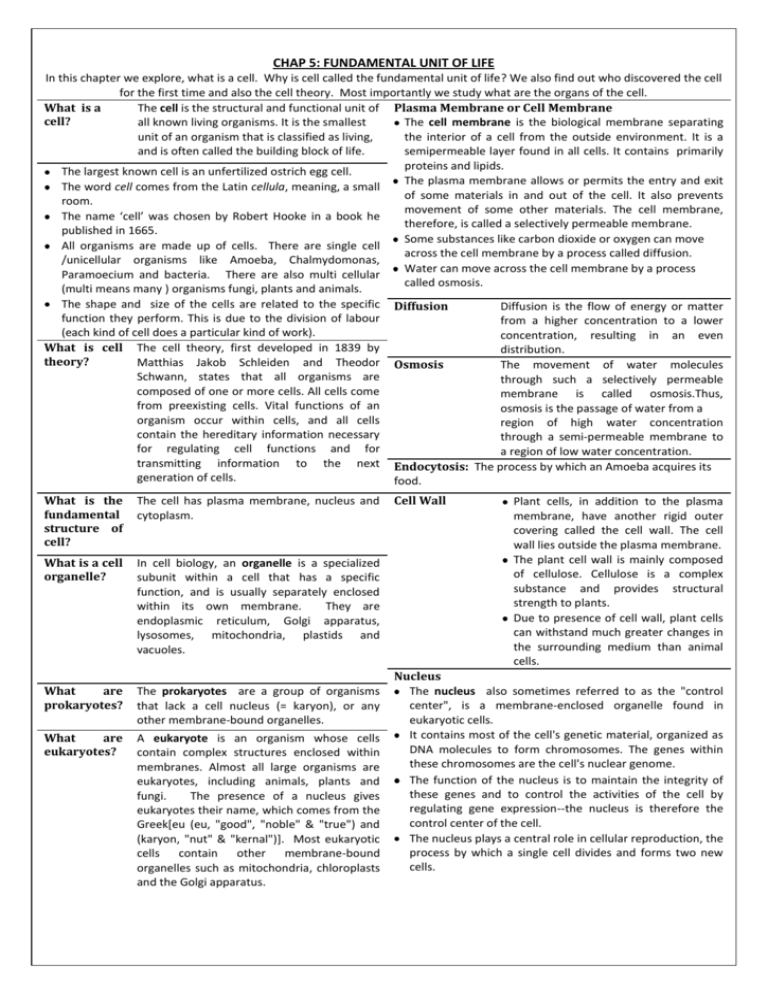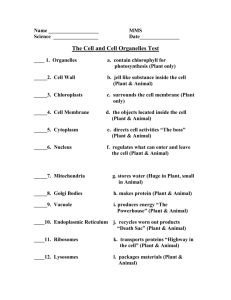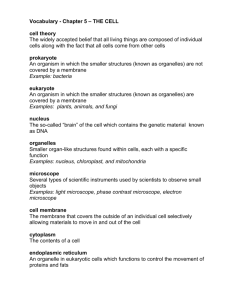CHAP 5: FUNDAMENTAL UNIT OF LIFE
advertisement

CHAP 5: FUNDAMENTAL UNIT OF LIFE In this chapter we explore, what is a cell. Why is cell called the fundamental unit of life? We also find out who discovered the cell for the first time and also the cell theory. Most importantly we study what are the organs of the cell. What is a The cell is the structural and functional unit of Plasma Membrane or Cell Membrane cell? all known living organisms. It is the smallest The cell membrane is the biological membrane separating unit of an organism that is classified as living, the interior of a cell from the outside environment. It is a and is often called the building block of life. semipermeable layer found in all cells. It contains primarily proteins and lipids. The largest known cell is an unfertilized ostrich egg cell. The plasma membrane allows or permits the entry and exit The word cell comes from the Latin cellula, meaning, a small of some materials in and out of the cell. It also prevents room. movement of some other materials. The cell membrane, The name ‘cell’ was chosen by Robert Hooke in a book he therefore, is called a selectively permeable membrane. published in 1665. Some substances like carbon dioxide or oxygen can move All organisms are made up of cells. There are single cell across the cell membrane by a process called diffusion. /unicellular organisms like Amoeba, Chalmydomonas, Water can move across the cell membrane by a process Paramoecium and bacteria. There are also multi cellular called osmosis. (multi means many ) organisms fungi, plants and animals. The shape and size of the cells are related to the specific Diffusion Diffusion is the flow of energy or matter function they perform. This is due to the division of labour from a higher concentration to a lower (each kind of cell does a particular kind of work). concentration, resulting in an even What is cell The cell theory, first developed in 1839 by distribution. theory? Matthias Jakob Schleiden and Theodor Osmosis The movement of water molecules Schwann, states that all organisms are through such a selectively permeable composed of one or more cells. All cells come membrane is called osmosis.Thus, from preexisting cells. Vital functions of an osmosis is the passage of water from a organism occur within cells, and all cells region of high water concentration contain the hereditary information necessary through a semi-permeable membrane to for regulating cell functions and for a region of low water concentration. transmitting information to the next Endocytosis: The process by which an Amoeba acquires its generation of cells. food. What is the fundamental structure of cell? The cell has plasma membrane, nucleus and cytoplasm. What is a cell organelle? In cell biology, an organelle is a specialized subunit within a cell that has a specific function, and is usually separately enclosed within its own membrane. They are endoplasmic reticulum, Golgi apparatus, lysosomes, mitochondria, plastids and vacuoles. What are prokaryotes? The prokaryotes are a group of organisms that lack a cell nucleus (= karyon), or any other membrane-bound organelles. What are eukaryotes? A eukaryote is an organism whose cells contain complex structures enclosed within membranes. Almost all large organisms are eukaryotes, including animals, plants and fungi. The presence of a nucleus gives eukaryotes their name, which comes from the Greek[eu (eu, "good", "noble" & "true") and (karyon, "nut" & "kernal")]. Most eukaryotic cells contain other membrane-bound organelles such as mitochondria, chloroplasts and the Golgi apparatus. Cell Wall Plant cells, in addition to the plasma membrane, have another rigid outer covering called the cell wall. The cell wall lies outside the plasma membrane. The plant cell wall is mainly composed of cellulose. Cellulose is a complex substance and provides structural strength to plants. Due to presence of cell wall, plant cells can withstand much greater changes in the surrounding medium than animal cells. Nucleus The nucleus also sometimes referred to as the "control center", is a membrane-enclosed organelle found in eukaryotic cells. It contains most of the cell's genetic material, organized as DNA molecules to form chromosomes. The genes within these chromosomes are the cell's nuclear genome. The function of the nucleus is to maintain the integrity of these genes and to control the activities of the cell by regulating gene expression--the nucleus is therefore the control center of the cell. The nucleus plays a central role in cellular reproduction, the process by which a single cell divides and forms two new cells. Cytoplasm Endoplasmic reticulum Biogenesis. Golgi Apparatus, Lysosomes The cytoplasm is the part of a cell that is enclosed within the plasma membrane. In eukaryotic cells, the cytoplasm contains organelles, such as mitochondria, which are filled with liquid that is kept separate from the rest of the cytoplasm by biological membranes. The contents of the cell nucleus are not part of the cytoplasm and are instead called the nucleoplasm. The cytoplasm is the site where most cellular activities occur. The endoplasmic reticulum (ER) is a eukaryotic organelle that forms an interconnected network of tubules and sheets within cells. There are two types of ER– rough endoplasmic reticulum (RER) and smooth endoplasmic reticulum (SER). RER looks rough under a microscope because it has particles called ribosomes attached to its surface. The ribosomes, which are present in all active cells, are the sites of protein manufacture. The manufactured proteins are then sent to various places in the cell depending on need, using the ER. The SER helps in the manufacture of fat molecules, or lipids, important for cell function. Some of these proteins and lipids help in building the cell membrane. The ER functions both as a passageway for intracellular transport and as a manufacturing surface. The lipids and proteins manufactured by SER help in building the cell membrane. The process is known as membrane biogenesis. The Golgi apparatus is an organelle found in most eukaryotic cells. It consists of a system of membranebound vesicles arranged approximately parallel to each other in stacks called cisterns. The material synthesised near the ER is packaged and dispatched to various targets inside and outside the cell through the Golgi apparatus. Its functions include the storage, modification and packaging of products in vesicles. In some cases, complex sugars may be made from simple sugars in the Golgi apparatus. The Golgi apparatus is also involved in the formation of lysosomes. Lysosomes are organelles containing digestive enzymes . They are found in animal cells, while in plant cells the same roles are performed by the vacuole. Lysosomes are a kind of waste disposal system of the cell. Lysosomes Mitochondria Plastids Vacuole Lysosomes help to keep the cell clean by digesting any foreign material as well as worn-out cell organelles. During the disturbance in cellular metabolism, lysosomes may burst and the enzymes digest their own cell. Therefore, lysosomes are also known as the ‘suicide bags’ of a cell. Lysosomes are membrane-bound sacs filled with digestive enzymes. These enzymes are made by RER. A mitochondrion (plural mitochondria) is a membrane-enclosed organelle found in most eukaryotic cells. Mitochondria are sometimes described as "cellular power plants" because they generate most of the cell's supply of adenosine triphosphate (ATP), used as a source of chemical energy. ATP is known as the energy currency of the cell. Mitochondria have two membrane coverings instead of just one. The outer membrane is very porous while the inner membrane is deeply folded. These folds create a large surface area for ATPgenerating chemical reactions. Mitochondria have their own DNA and ribosomes. Therefore, mitochondria are able to make some of their own proteins. Plastids are present only in plant cells. There are two types of plastids – chromoplasts (coloured plastids) and leucoplasts (white or colourless plastids). Plastids containing the pigment chlorophyll are known as chloroplasts. Chloroplasts are important for photosynthesis in plants. Leucoplasts are primarily organelles in which materials such as starch, oils and protein granules are stored. Like the mitochondria, plastids also have their own DNA and ribosomes. A vacuole is a membrane organelle which is present in all plant and fungal cells and some animal . Vacuoles are small sized in animal cells while plant cells have very large vacuoles. Vacuole store amino acids, sugars, various organic acids and some proteins. In some unicellular organisms, specialised vacuoles also play important roles in expelling excess water and some wastes from the cell. Most mature plant cells have a large central vacuole that helps to maintain the turgidity of the cell and stores important substances including wastes.









